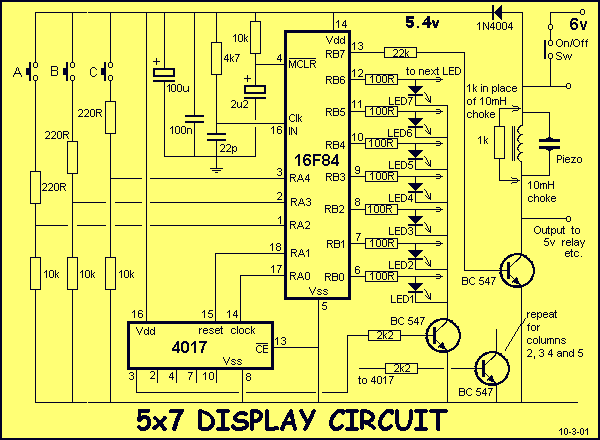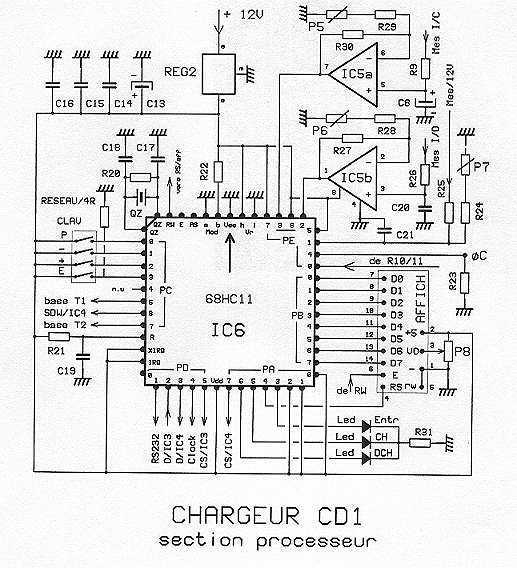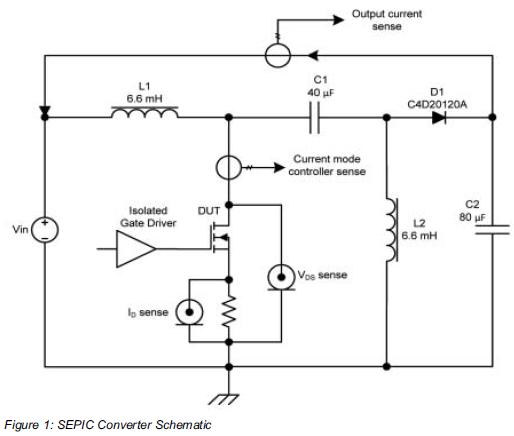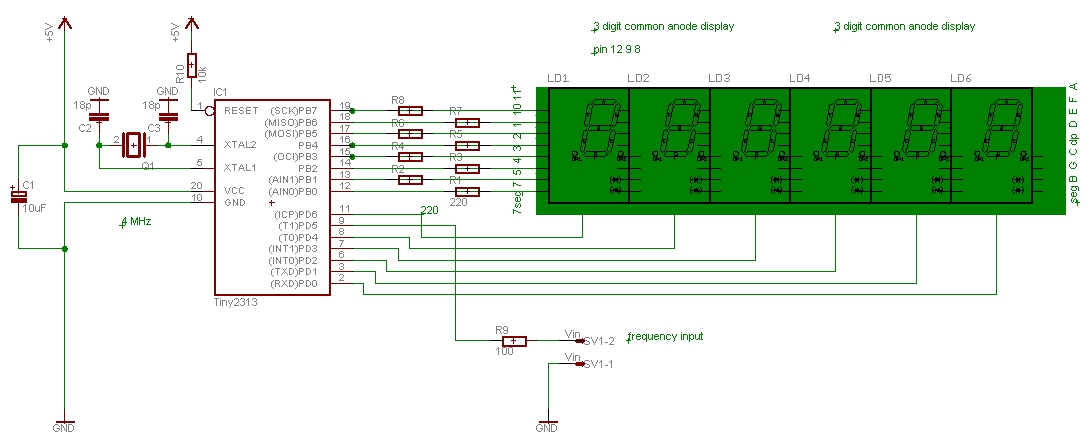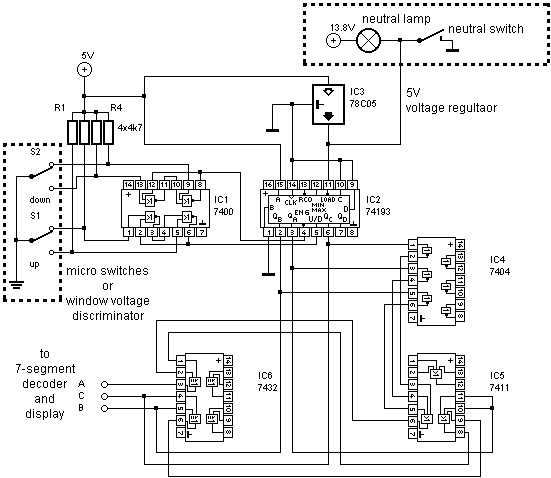
Single Display LED Frequency Counter
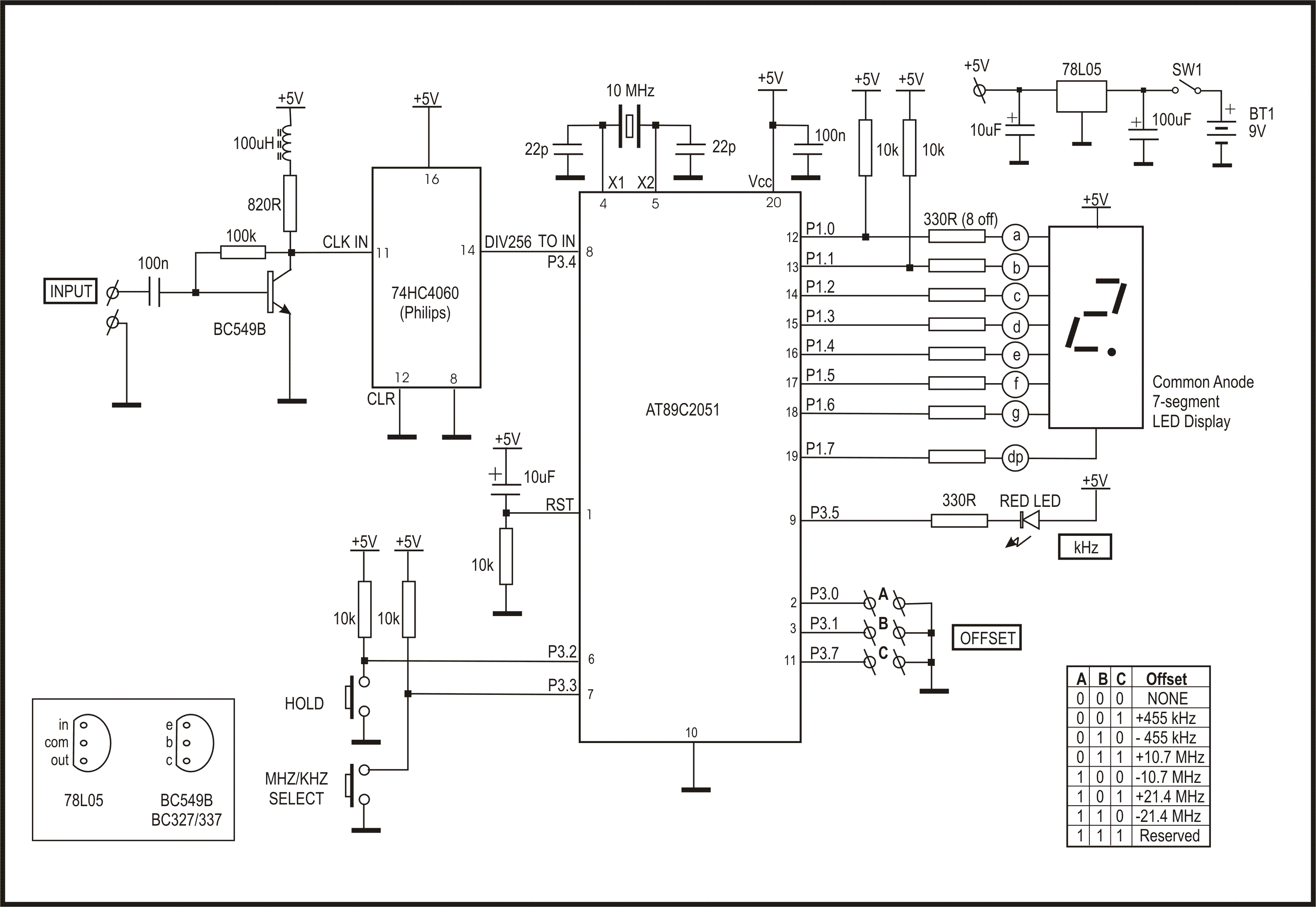
As equipment becomes increasingly compact, designers are often required to reduce the size of displays. However, this can compromise the usefulness of the display. Many individuals find it challenging to read small displays, which can be particularly frustrating. In the search for suitable displays for compact equipment, one solution explored was the use of a single seven-segment LED to display multiple digits. This approach could provide the necessary functionality while minimizing display size. A sufficiently large LED digit would allow information to be viewed from a distance without causing eye strain. A practical example of this concept is a lightweight and rugged portable frequency counter that operates up to 65 MHz. Utilizing only a large single LED display, it shows frequency measurements with five digits of resolution (to the nearest kHz) in a compact design that can fit in a shirt pocket. Initial tests indicated that displaying multi-digit frequency measurements is most effective when presented in series of three-digit bursts. Displaying more than this can lead to confusion. Each set of three digits is shown for approximately 300 ms, followed by a brief pause, and a longer pause of about one second to signify the end of the three-digit sequence. There is a trade-off in timing; longer display durations make initial reading easier, but the total time required to read all digits can become tedious. To display five digits of frequency information, a MHz/kHz button is used to select the desired set of three digits, accompanied by an LED indicator to show which digits are being displayed. For instance, to display a frequency of 59.876 MHz, the counter will show 5 9. 8 (pause) in MHz mode and 8 7 6 (pause) in kHz mode. A second button allows the measured frequency to be held on the display. A short probe can be attached directly to the input connector, which may obscure the display during measurement. By pressing the Hold button, the measurement is retained, allowing the counter to be removed for easier reading. The counter is designed for simplicity, utilizing only two chips: an Atmel AT89C2051 microprocessor and a low-cost CMOS divider. A BC549 NPN transistor serves as a buffer amplifier. The buffered input is divided by 256 using a 74HC4060 divider, with a preference for Philips ICs over Fairchild for better performance. The Atmel 89C2051 microprocessor operates with a 10 MHz HC-49U crystal, which serves as the reference oscillator. The software is compatible with any standard 8051 family device, and the source code, along with the Intel-format HEX file, is available for users to modify or enhance.
The described frequency counter circuit utilizes a compact design to achieve functionality while maintaining readability. The core components include the Atmel AT89C2051 microprocessor, which is responsible for processing the input frequency and managing the display output. The microprocessor is clocked by a 10 MHz crystal oscillator, ensuring accurate timing for frequency measurement.
The 74HC4060 divider plays a crucial role in reducing the input frequency for display purposes. By dividing the input frequency by 256, the circuit can effectively handle higher frequency signals, up to 65 MHz, while keeping the display manageable. The choice of using a BC549 NPN transistor as a buffer amplifier allows for improved signal integrity, ensuring that the microprocessor receives a clean signal for processing.
The display mechanism relies on a single seven-segment LED, which is capable of presenting frequency data in bursts. The use of three-digit bursts minimizes confusion and enhances readability. The timing of the display is carefully calibrated to balance between visibility and overall reading speed. The inclusion of a MHz/kHz toggle allows users to switch between frequency ranges, further enhancing the usability of the device.
In conclusion, this frequency counter exemplifies an effective approach to compact display technology, combining a minimalist design with practical functionality. The choice of components and the thoughtful arrangement of the display output contribute to a user-friendly experience, making it an ideal tool for portable frequency measurement applications.As equipment becomes increasingly more compact, designers are often obliged to follow suit by reducing the size of displays. At some point, the usefulness of the display can become compromised. I, for one, dislike having to peer intently at tiny displays in an attempt to read vital information, if only because it serves as a reminder that my eyesi
ght is no longer the 20:20 model of optical perfection I`d like to pretend it once was. In the search for suitable displays for compact equipment, I explored using a single seven-segment LED to display multiple digit information. If successful, this could both deliver the required functionality and minimise display size. With a suitably large LED digit, information could also be seen from some distance without the need for eye strain.
But is such a display practical in real applications This little frequency counter suggests that it is. It is a lightweight and remarkably rugged portable frequency counter which will readily operate up to 65 MHz.
While using only a large single LED display, it displays a frequency with five digits of resolution (i. e. to the nearest kHz) in a package which can be easily carried in a shirt pocket. Some initial tests showed that displaying multi-digit frequency measurements on a single display is best handled by displaying the information in a series of three digit bursts.
Any more information than this seemed to introduce the potential for confusion. In this case, each set of three digits is sequentially displayed for about 300mS per digit with a short inter-digit pause of about half this duration. This is followed by a longer pause of about a second to clearly flag the end of the three digits of information.
There is clearly something of a tradeoff in this timing. A longer duration for each digit makes it easier to initially read the information, but the overall time required to read all of the digits can quickly become tedious. In order to display five digits of frequency information, as in this counter, I have used a MHz/kHz button to select the required set of three digits, and matching LED indicator to clearly show the set of digits being displayed.
To display a frequency of 59. 876 MHz, for example, the counter displays 5 9. 8 (pause) repeatedly while in the MHz mode (with a decimal point displayed along with the MHz units numeral), and 8 7 6 (pause) repeatedly in the kHz mode. A second button allows a measured frequency to be held in the counter. I can use the counter with a short probe directly attached to the input connector. In some cases, this can result in the display being out of sight during the measurement. By touching the Hold button, the required measurement is retained, and the counter can then be removed from the equipment to allow the frequency display to be read.
With an eye on simplicity, the counter uses only two chips an Atmel AT89C2051 microprocessor and a low cost CMOS divider. A common BC549 NPN transistor acts as a buffer amplifier for the counter. The buffered input is divided by 256 in the 74HC4060 divider. Use a Philips IC here if possible, or at least simply avoid using a Fairchild HC4060 here. I`m uncertain if processes have improved over at Fairchild in the past couple of years, but their HC parts that I`ve tested seem to be limited in operation to 25 MHz.
The Philips HC devices I have tried all work up to 80 MHz. The microprocessor I used is an Atmel 89C2051, one of the 8051 family. A low cost 10 MHz HC-49U crystal is used to clock the microprocessor, and this forms the reference oscillator for the counter. The software can be used with any standard 8051 family device (i. e. 89C51, 87C751 etc) and the code, as usual, is available at the foot of this page in the Download section.
I have posted both the fully commented source code as well as the Intel-format HEX file. Publishing the source code allows others to add features they may prefer to the software, 🔗 External reference
The described frequency counter circuit utilizes a compact design to achieve functionality while maintaining readability. The core components include the Atmel AT89C2051 microprocessor, which is responsible for processing the input frequency and managing the display output. The microprocessor is clocked by a 10 MHz crystal oscillator, ensuring accurate timing for frequency measurement.
The 74HC4060 divider plays a crucial role in reducing the input frequency for display purposes. By dividing the input frequency by 256, the circuit can effectively handle higher frequency signals, up to 65 MHz, while keeping the display manageable. The choice of using a BC549 NPN transistor as a buffer amplifier allows for improved signal integrity, ensuring that the microprocessor receives a clean signal for processing.
The display mechanism relies on a single seven-segment LED, which is capable of presenting frequency data in bursts. The use of three-digit bursts minimizes confusion and enhances readability. The timing of the display is carefully calibrated to balance between visibility and overall reading speed. The inclusion of a MHz/kHz toggle allows users to switch between frequency ranges, further enhancing the usability of the device.
In conclusion, this frequency counter exemplifies an effective approach to compact display technology, combining a minimalist design with practical functionality. The choice of components and the thoughtful arrangement of the display output contribute to a user-friendly experience, making it an ideal tool for portable frequency measurement applications.As equipment becomes increasingly more compact, designers are often obliged to follow suit by reducing the size of displays. At some point, the usefulness of the display can become compromised. I, for one, dislike having to peer intently at tiny displays in an attempt to read vital information, if only because it serves as a reminder that my eyesi
ght is no longer the 20:20 model of optical perfection I`d like to pretend it once was. In the search for suitable displays for compact equipment, I explored using a single seven-segment LED to display multiple digit information. If successful, this could both deliver the required functionality and minimise display size. With a suitably large LED digit, information could also be seen from some distance without the need for eye strain.
But is such a display practical in real applications This little frequency counter suggests that it is. It is a lightweight and remarkably rugged portable frequency counter which will readily operate up to 65 MHz.
While using only a large single LED display, it displays a frequency with five digits of resolution (i. e. to the nearest kHz) in a package which can be easily carried in a shirt pocket. Some initial tests showed that displaying multi-digit frequency measurements on a single display is best handled by displaying the information in a series of three digit bursts.
Any more information than this seemed to introduce the potential for confusion. In this case, each set of three digits is sequentially displayed for about 300mS per digit with a short inter-digit pause of about half this duration. This is followed by a longer pause of about a second to clearly flag the end of the three digits of information.
There is clearly something of a tradeoff in this timing. A longer duration for each digit makes it easier to initially read the information, but the overall time required to read all of the digits can quickly become tedious. In order to display five digits of frequency information, as in this counter, I have used a MHz/kHz button to select the required set of three digits, and matching LED indicator to clearly show the set of digits being displayed.
To display a frequency of 59. 876 MHz, for example, the counter displays 5 9. 8 (pause) repeatedly while in the MHz mode (with a decimal point displayed along with the MHz units numeral), and 8 7 6 (pause) repeatedly in the kHz mode. A second button allows a measured frequency to be held in the counter. I can use the counter with a short probe directly attached to the input connector. In some cases, this can result in the display being out of sight during the measurement. By touching the Hold button, the required measurement is retained, and the counter can then be removed from the equipment to allow the frequency display to be read.
With an eye on simplicity, the counter uses only two chips an Atmel AT89C2051 microprocessor and a low cost CMOS divider. A common BC549 NPN transistor acts as a buffer amplifier for the counter. The buffered input is divided by 256 in the 74HC4060 divider. Use a Philips IC here if possible, or at least simply avoid using a Fairchild HC4060 here. I`m uncertain if processes have improved over at Fairchild in the past couple of years, but their HC parts that I`ve tested seem to be limited in operation to 25 MHz.
The Philips HC devices I have tried all work up to 80 MHz. The microprocessor I used is an Atmel 89C2051, one of the 8051 family. A low cost 10 MHz HC-49U crystal is used to clock the microprocessor, and this forms the reference oscillator for the counter. The software can be used with any standard 8051 family device (i. e. 89C51, 87C751 etc) and the code, as usual, is available at the foot of this page in the Download section.
I have posted both the fully commented source code as well as the Intel-format HEX file. Publishing the source code allows others to add features they may prefer to the software, 🔗 External reference

